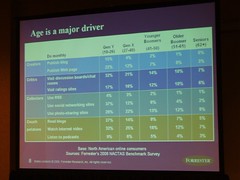Nicholas Negroponte was the keynote this morning, discussing the One Laptop Per Child program.
Some points:
- 1.2B worldwide children in primary/secondary schools
- 50% w/o electricity
- 50% in rural parts of the world
- 50% in china & india
- There is some overlap b/w above groups
OLPC is taking an interesting path. Some say more teachers, more schools are the keys to education…and those are good. And that will take a VERY long time.
What can we do in the meantime, to leverage the children themselves? Can we think about learning as “the things we know,” as opposed to learning equating to “teaching.” We learn via interacting with the environment and each other. That kind of learning … walking, talking, common sense… ends at age six. At that point, the process switches from “experience” to “teaching.” However…in addition to teaching, there are other forms of learning. This peer-to-peer learning is what can be enabled with this project.
 It’s a laptop because it needs to be a part of their lives…there’s no “this is work, this is school, this is fun”…there should be no separation between the areas. It should just be there.
It’s a laptop because it needs to be a part of their lives…there’s no “this is work, this is school, this is fun”…there should be no separation between the areas. It should just be there.
Kids love ’em. They charge them up at night at the school. Parents love ’em because they are the brightest light source in the house.
It’s about SCALE, SCALE, SCALE. 5-10 million in 2007, 50-100 million in 2008. Scale changes corporate strategy.
(Very cool tech note: each laptop is a node in a mesh network…even when the laptop is closed!)
Launch countries
Great insight: “If anyone in this room has a use for the CAPS LOCK key, please send me an email! Who put that thing there, right above the shift key?”
Funny exchange:
Forrester: Bill Gates said “The last thing you want for a shared use computer…”
Negroponte, interrupting: “Huh? Shared use? This is One.Laptop.Per.Child. Continue…”
Forrester: “…with a tiny little screen…”
Negroponte, interrupting: “Huh? Tiny little screen? The screen is 1/2″ LARGER than Bill’s ‘Origami’ computer.”
Interesting intellectual property note: OLPC is patenting the aspects of the machine as quickly as they can…the display, the charger, etc. are being patented in order to ensure the OLPC program will always be able to use the tech, and not get boxed out by other folks who might subsequently claim prior art.
Final quote: “We think of the kids as CREATORS, not recipients. They are makers of things. MAKE is a key word. SHARE is a key word.”





 A net-positive presentation from Roger C. Hochschild, President and COO, Discover Financial Services. Hochschild seems to get it. Two particular areas of focus of note, with respect to connecting with their customers: Clarity and Control.
A net-positive presentation from Roger C. Hochschild, President and COO, Discover Financial Services. Hochschild seems to get it. Two particular areas of focus of note, with respect to connecting with their customers: Clarity and Control.

